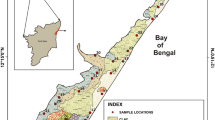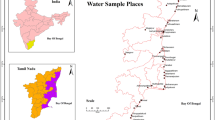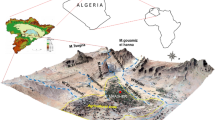Abstract
Saltwater intrusion is the critical concern commonly confronted in coastal aquifers around the world. This study assessed the principal physicochemical parameters influencing groundwater quality in the coastal areas of Visakhapatnam City by investigating the potential origins of seawater intrusion. First is an integrated approach wherein a primary survey was conducted to establish the quality and quantity of groundwater in the coastal areas of Visakhapatnam City. The groundwater vulnerability to seawater intrusion was analysed using four different methods. This study evaluated ionic molar ratios using multivariate statistical techniques, including hierarchical cluster analysis (HCA) and principal component analysis (PCA), GALDIT model. Hydrochemical evolution diagrams further support the analysis to assess the extent of seawater intrusion in the study area. Ionic ratios suggest that there are early signs of seawater intrusion into groundwater. From PCA, PC 1, the salinisation factor was evaluated for each season based on the variance percentage. Hierarchical cluster analysis grouped the 20 groundwater quality parameters into two key clusters. In the second cluster, the TDS and EC were the dominant parameters in all the seasons. The GALDIT model showed that about 10 (i.e. 33.33%) in pre-monsoon and 7 (i.e. 23.3%) out of 30 sampling stations fell under moderately vulnerable seawater intrusion while the rest fall under low-risk zones. The study with hydrochemical evolution diagrams indicates that Chepaluppada, Mangamaripeta and Jalaripeta in the pre-monsoon and Chepalappada, Timmapuram and Beach Road in the post-monsoon seasons are prone for seawater intrusion.




Similar content being viewed by others
References
Werner AD, Bakker M, Post VEA, Vandenbohede A, Lu C, Bd A-A, Simmons CT, Barry DA (2013) Seawater intrusion processes, investigation and management: recent advances and future challenges. Adv Water Resour 51:3–26. https://doi.org/10.1016/j.advwatres.2012.03.004
Allen D M and Liteanu, E. (2008) Long term dynamics of saltwater freshwater interface on the Gulf Islands, British Columbia, Canada. In. G. Barrocu (Ed) Proceedings of the First International Joint Saltwater Intrusion Conference, Swim- WICA, Cagliari, Italy, pp 24-29
APHA (2005) American Public Health Assoc. Standard methods for the examination of water and wastewater. 21st Edition. American Public Health. Assoc., USA
Appelo CAJ and Postma D (2005) Geochemistry, groundwater and pollution, CRC Press: Boca Raton, FL; 649, 3rd edition
Appelo CAJ and Postma, D (2006) Geochemistry, groundwater and pollution. AA Rotterdam: Balkema. 2nd edition
Barlow PM, Reichard E (2010) Saltwater intrusion in coastal regions of North America. Hydrogeol J 18:247–260
Bear J (1999) Seawater intrusion in coastal aquifers: concepts, methods and practices, Boston. Mass: Kluwer Academic
Bouhlila R, Laabidi E (2008) Impacts of calcite dissolution on seawater intrusion processes in coastal aquifers: density-dependent flow and multispecies reactive transport modeling. Calibration and reliability in groundwater modelling credibility of modelling. IAHS Publ 320:220–225
Chahed J, Hamdane A, Besbes M (2008) A comprehensive water balance of Tunisia: blue water, green water and virtual water. Water Int 33:415–424
Chachadi AG and Lobo Ferreira JP (2001) Seawater intrusion vulnerability mapping of aquifers using the GALDIT method. COASTIN - A CoastalPolicy Research Newsletter. Proceedings of the Workshop on Modelling in Hydrogeology, Anna University, Chennai.143-156
Chen KP, Jiao JJ (2007) Seawater intrusion and aquifer freshening near reclaimed coastal area of Shenzhen. Water Sci Technol: Water Supply 7:137–145
Datt PS, Tyagi SK (1977) Major ion chemistry of groundwater Delhi area: weathering processes and groundwater flow regime. Geol Soc India 47:179–188
Devaraj N, Thivya C, Thilagavathi R, Aditya VS, Chidambaram S (2016) A study on the hydrogeochemical processes groundwater quality of Ariyalur region, Tamilnadu. Int J Curr Res Dev 4:113
Giménez-Forcada E, San Román FJS (2014) An excel macro to plot the HFE-diagram to identify seawater intrusion phases. Groundwater. https://doi.org/10.1111/gwat.12280
Gomis-YagüesV B-BN, Ruiz-Bevia F (2000) Gypsum precipitation/dissolution as an explanation of the decrease of sulphate concentration during seawater intrusion. J Hydrol 228:48–55
Guler C, Thyne G, Mccray J, Turner A (2002) Evaluation of graphical and multivariate statistical methods for classification of water chemistry data. Hydrogeol J 10:455–474
Pandve HT (2010) Climate change and coastal mega cities of India, Indian J Occup environ med. Jan-Apr 14:22–23
Hem, JD (1991) Study and interpretation of the chemical. Characteristics of natural waters. U. S. Geological Survey Professional Paper 2254, 3 ed. Scientific Publishers, Jodhpur, 263p.
Howard KWF, Mullings E (1996) Hydrochemical analysis of groundwater-flow and saline incursion in the Clarendon Basin, Jamaica. Ground-water 34:801–810
Howard KWF, Lloyd JW (1984) Major ion characterisation of coastal saline ground waters. Ground-water 21:429–437
Hussein MT (2003) Hydrochemical evaluation of groundwater in the Blue Nile Basin, eastern Sudan, using conventional and multivariate techniques. Hydrogeol J 12:144–158
HydroMetrics LLC (2008) Seawater intrusion analysis report. Seaside Groundwater Basin, Monterey County, California
Izuka SK, Gingerich S (1998) Estimation of the depth to the freshwater/saltwater interface from vertical head gradients in wells in coastal and island aquifers. Hydrogeol J 6:365–373
Jeffrey C, Vic E, Chris M, Ali M, David W, Michael CS, Joseph DH (2018) Economic impacts of urban flooding in South Florida: potential consequences of managing groundwater to prevent salt water intrusion. Sci Total Environ 621:465–447
Jeyaprakash M, Giridharan L, Venugopal T, Krishnakumar SP, Periyakali P (2008) Characterisation and evaluation of the factors affecting the geochemistry of groundwater in Neyveli, Tamil Nadu. India Environ Geol 54:855–867
Jones BF, Vengosh A, Rosenthal E, Yechieli Y (1999) Geochemical investigation of groundwater quality. Seawater intrusion in coastal aquifers – concepts, methods and practices, In, pp 51–71
Panagopoulos GP, Antonakos AK, Lambrakis NJ (2006) Optimisation of the DrASTIC method for groundwater vulnerability assessment via the use of simple statistical methods and GIS. Hydrogeol J 14:894–911
Kaiser HF (1960) The application of electronic computers to factor analysis. Educ Psychol Measurement 20:141–151
Kavidha R, Elangovan K (2014) Seasonal variation of groundwater quality in Erode District, Tamil Nadu. India J Environ Sci Eng 6:295–302
Kennedy G A (2012) Development of a GIS-based approach for the assessment of relative seawater intrusion vulnerability in Nova Scotia, Canada. Nova Scotia Department of Natural Resources, AH 2012 Congress, Niagara Falls
Khelif S, Boudoukha A (2018) Multivariate statistical characterisation of groundwater quality in Fesdis. East Algeria J Water Land Dev 37:65–74
Kim JH, Kim RH, Chang HW (2003) Hydro geochemical characterisation of major factors affecting the quality of shallow ground-water in the coastal area at Kimje in South Korea. Environ Geol:478–489
Kosmas C, Tsara M, Moustakas N, Kosma D. and Yassoglou N (2006) Environmentally sensitive areas and indicators of desertification. In: W. Kepner, G., J.L. Rubio, A. David and M. Pedrazzini (Editors), NATO security through science series. Desertification in the Mediterranean Region. A Security Issue, 527-547
Kumar KK (2011) Geomorphological impact assessment on groundwater quality and fluoride genesis along the bay of Bengal of Visakhapatnam District, Andhra Pradesh. India Clean Soil Air Water 39:925–930
Laaksoharaju M, Gurban I, Skarman C, Skarman E (1999) Multivariate mixing and mass balance (M3) calculation, a new tool for decoding hydrogeochemical information. Appl Geochem 14:861–871
Lawrence FW, Upchurch SB (1982) Identification of recharge areas using geochemical factor analysis. Ground Water 20:680–687
Lee JY, Song SH (2007a) Evaluation of groundwater quality in coastal areas: implications for sustainable agriculture. Environ Geol 52:1231–1242
Lee JY, Song SH (2007b) Groundwater chemistry and ionic ratios in a western coastal aquifer of Buan, Korea: implication for seawater intrusion. Geosci J 11:259–270
Mohapatra PK, Vijay R, Pujari PR, Sundaray SK, Mohanyt BP (2011) Determination of process affecting groundwater quality in the coastal aquifer beneath Puri city, India: a multivariate statistical approach. Water Sci Technol 64:809
Montety VD, Radakovitch O, Vallet-Coulomb C, Blavoux B.and Hermitte D (2006) The use of natural tracers to highlight seawater intrusion in the confined coastal aquifer of the Rhone Delta.in Proc. 1st SWIM-SWICA Joint Saltwater Intrusion Conference, Cagliari-Chia Laguna, Italy
Moujabber EM, Bou SB, Darwish T, Atallah T (2006) Comparison of different indicators for groundwater contamination by seawater intrusion on the Lebanese coast. Water Resour Manag 2:161–180
Nair IS (2016) Assessment of seawater intrusion in an alluvial aquifer by hydrochemical-isotopic signatures and geochemical modeling. PhD thesis, Anna University
Nwankwoala HO, Udom GJ (2011) Hydrochemical facies and ionic ratios of ground-water in Port Harcourt, southern Nigeria. Res.J.Chem.Sci 1:87–101
Panno SV, Hackley KC, Hwang HH, Greenberg SE, Krapac IG, Landberger S, O’Kelly DJO (2006) Characterisation and identification of Na-cl sources in groundwater. Ground-Water 44(2):176–187
Pantelis MS, Maria K, Filippos V, Antonis V, George S (2007) Estimation of aquifer hydraulic parameters from surficial geophysical methods: a case study of Keritis Basin in Chania (Crete – Greece). J Hydrol 338:122–131
Raja G, Venkatesan P (2010) Assessment of groundwater pollution and its impact in and around Punnam area of Karur District, Tamil Nadu, India. E-J Chem 7(2):473–478
Rengaraj S, Elapooram T, Elango L, Ramalingam V (1996) Groundwater quality in suburban regions of Madras city, India. Pollut Res 15:367–370
Reza D, Ahmad A, Zohreh K, Indika H, Jochen B (2019) Hydrogeochemical controls on arsenic mobility in an arid inland basin. Southeast of Iran: the role of alkaline conditions and saltwater intrusion. Environ Poll 249:910–922
Richter BC and Kreitler CW(1991) Identification of sources of groundwater salinisation using geochemical techniques, US Environmental Protection Agency, Oklahoma
Ritzi RW, Wright SL, Mann B, Chen M (1993) Analysis of temporal variability in hydrogeochemical data used for multivariate analyses. Ground Water 31:221–229
Sanchez-Martos F, Pulido-Bosch A, Molina-Sanchez L, VallejosIzquierdo A (2002) Identification of the origin of salinisation in groundwater using minor ions (lower ANDARAX, southeast. Spain). Sci Total Environ 29:43–58
Kulkarni H, Shah M and Vijay Shankar PS (2014) Shaping the contours of ground water governance in India. http://ac.els-cdn.com/S2214581814000469/1-s2.0-S2214581814000469-main.pdf?_tid=34057068-a499-11e5-90f300000aacb362&acdnat=1450341541_4c147174ec4f214578113853e69b8bb3
Simpson TR. (1946) Salinas basin investigation. Bulletin 52, California Division of Water Resources, Sacramento
Subba Rao N, Prakasa Rao J, Subrahmanyam A (2007) Principal component analysis in groundwater quality in a developing urban area of Andhra Pradesh. J Geol Soc India 69:959–969
Subba Rao N (2008) Groundwater quality monitoring in an urban area for sustainable development. Environ Geosci 15(2):63–73
Tesoriero AJ, Inkpen EL, Voss F (1998) Assessing groundwater vulnerability using logistic regression. Proceedings for the source WaterAssessment and protection 98 conference, Dallas, TX, 157–165.
Tran T, Phu L, Vu N, Ho B (2019) Salt intrusion adaptation measures for sustainable agricultural development under climate change effects: a case of Ca Mau peninsula. Vietnam Climate Risk Manag 23:88–100
UN-Water RIO+20 Report (2012) www.Un water.org/rio /report/pressrelease-19 june.html
Vidya S, Purandara BK, Shivapur AV, Davithuraj J (2020) Assessment of aquifer vulnerability using GALDIT model – a case study. J Geol Soc India 95:507–512
MZ (2011) Water quality decline in coastal aquifers under anthropic pressure: the case of a suburban area of Dakar (Senegal). Environ Monit Assess 172:605–622
Washington State Department of Ecology (2005) Water Resource Inventory Area 06 Islands, Seawater Intrusion Topic Paper. Retrieved from: https://fortress.wa.gov/ecy/publications/ Summary Pages /1203271. HTML Accessed: July 10, 2018
Water Quality for Ecosystems and Human Health. 2nd edition. UNEP, ERCE, UNESCO. 2008
Web 1: http://hidrologia.usal.es/HFE-D.htm (n.d.)
Web 2: http://timesofindia.indiatimes.com/articleshow/58248681.cms? utm_ source=contentofinterest&utm_medium=text&utm_campaign=cppst
Web 3: National Water Policy, 2006: http://unpan1.un.org/intradoc/groups/public/documents/apcity/unpan042378.pdf
Web 4: https://www.mae.gov.nl.ca/waterres/training/adww/2015/04_Lynn_Pilgrim. pdf(n.d.)
Web 5: http://hidrologia.usal.es/HFE-D.htm(n.d.)
World Health Organization (WHO) (1982). Manual on environmental management for mosquito control with special emphasis on malaria vectors
Web 6 http://cgwb.gov.in/Documents/WQ-standards.pdf(n.d.)
World Health Organization (WHO) (2011) Guidelines for drinking water fourth edition, 4, Vol 38.WHO chronicle
Yang Q, Zhang J (2015) Wang. Y, fang Y, and Martín JD, multivariate statistical analysis of hydrochemical data for shallow ground water quality factor identification in a coastal aquifer. Pol. J Environ Stud 24(2):769–776
Zhang R, Hamerlinck JD, Gloss S, Munn L (1996) Determination of nonpoint-source pollution using GIS and numerical models. JourEnviron Quality 25:411–418
Acknowledgements
The authors acknowledge the support received from the Andhra University, Visakhapatnam, India and the University of KwaZulu-Natal, Durban, South Africa, in laboratory facilities.
Availability of data and material
Not applicable.
Code availability
Not applicable.
Author information
Authors and Affiliations
Corresponding author
Ethics declarations
Conflict of interest
The authors declare no competing interests.
Additional information
Responsible Editor: Broder J. Merkel
Supplementary Information
ESM 1
(DOCX 31 kb)
Rights and permissions
About this article
Cite this article
Korrai, S., Gangu, K.K., Rao, P.P. et al. Assessment of groundwater vulnerability to seawater intrusion using multiple approaches. Arab J Geosci 15, 545 (2022). https://doi.org/10.1007/s12517-021-08548-4
Received:
Accepted:
Published:
DOI: https://doi.org/10.1007/s12517-021-08548-4




